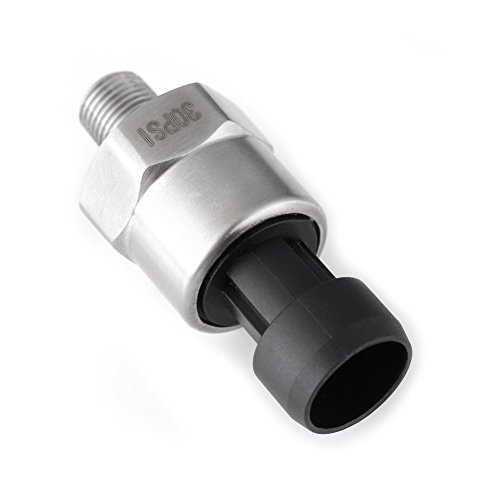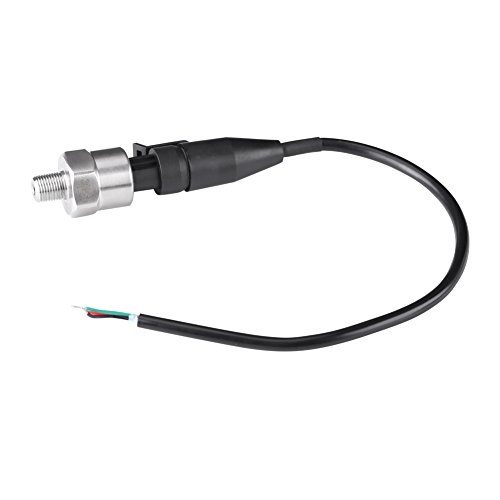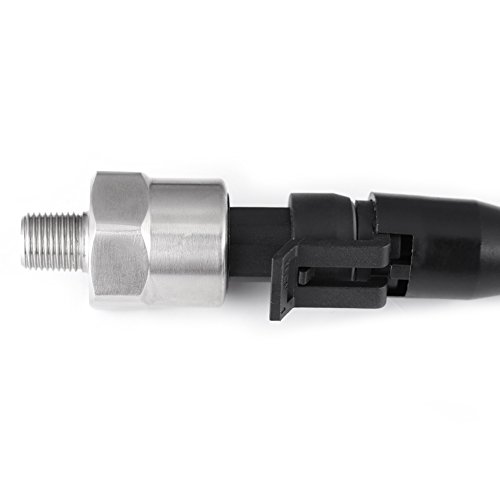







Size:30 PSI Specifications: Material: Stainless steel Voltage: DC 5V Pressure: 30 psi, 100 psi, 150 psi, 200 psi, 300 psi, 500 psi (Optional) Thread Type: 1/8" NPT 30 psi Input: 0-30 psi Output: 0.5V~4.5V linear voltage output. 0 psi outputs 0.5V, 15psi outputs 2.5V, 30 psi outputs 4.5V. Accuracy: within 2% of reading (full scale). Thread: 1/8"-27 NPT. Wiring Connector: Water sealed quick disconnect. Mating connector is included. Wiring: Red for +5V; Black for ground; Blue for signal output. Package Includes: 1 x Pressure Transducer (With cable)
A**R
Good sensor, innacurate specifications
This is a good, apparently industrial grade sensor. The photo shows the wire harness terminated with a JST connector - mine came with pigtails (with the automotive connector at the sensor as pictured). The sensor connector backshell is not rigidly attached to the connector, so do not pull on the backshell when removing the connector - pull on the locking tab, or you may risk pulling out the wires. I have the 150psi version connected to an Arduino Nano clone. Sensor provides stable, linear output over the full measurement range.The seller has provided some confusing information with regards to specifications and capabilities. The sensor is actually more capable than advertised. First and foremost is is an ABSOLUTE PRESSURE sensor. That being said, it will provide linear output under vacuum, and does not have any apparent hysteresis around ambient pressure. In addition, the specifications are ambiguous when it comes to the sensor response. Here are my observations (based on a test setup using a mechanical gauge, compressed air, and reading raw sensor output). Note that my pressure readings around zero were most likely affected by the hysteresis of the mechanical gauge:0 PSIG (Approx 15 PSIA) = 0.62V0 PSIA (extrapolated) = 0.11V - Note: I was able to see smooth readings when I pulled a vacuum on the sensor, but did not bother to make any calibrated measurements under vacuum because my application doesn't require vacuum.60 PSIG (Approx 75 PSIA) = 2.48V100 PSIG (Approx 115 PSIA) = 3.84V135 PSIG (extrapolated - approx 150 PSIA) = 4.93Vlinear scale factors (5V supply, 10-bit): 1.047 kPa/bit; 214.3 kPa/Volt; 0.1518 PSI/bit; 31.09 PSI/VoltI used Libre Office Calc (Excel) to plot the data, then a linear trendline with show equation to get the slope.Raw Data:PSIG ADC (raw, 10-bit/5Vref)0 12710 20420 24830 31140 37750 44760 50870 58280 65190 719100 786Hope this helps!
T**S
Works great!
Bought the 100 psi model for monitoring my RO system using a computer to get around the inaccurate mechanical pressure switches. Comparing this sensor output to a gauge in tandem leads me to believe the sensor is more accurate. Both tracked each other from 0-to 70 psi (highest I want to stress my system) and the gauge reading is within eyeball accuracy of the sensor's reported output.I have no trouble with leaks but then it's only the 100 psi version.
B**T
Save your money and buy a better sensor.
Ordered the 500PSI sensor. Worked for about 2 minutes, now oil leaks out of the connector... Save your money and buy a better sensor.
F**Y
Poor Reliability
This pressure sensor worked great.... for about four months and then failed. Also the "stainless steel" housing did not hold up very well (see picture of four month old sensor). To be fair, I do live near the ocean and several other items that make the stainless steel claim have also quickly rusted.
T**R
Looks well made and has acceptable accuracy
So far I have only tested this item at two pressures. At 0 psig I get 0.50 V, which is the expected output with no load. At 98 psig, as observed on a 0-120 psig dial gauge of unknown accuracy, I get 3.07 V, which corresponds to 96.4 psig. That is within the rated accuracy of +/-2% FS, which is 3 psi. The 150 PSI etching on the body is well formed and easy to read, the finish on the body is free of blemishes and the pigtail connector is made of a plastic that is flexible and tough enough to disconnect from the transducer without the retaining tab breaking off. The wires are only 26 Ga, but are pre-tinned and the insulation and jacket are a good thickness with a shielding foil inside the jacket around the three wires.
J**T
Can't beat this thing for the money!
This thing works awesome for the price! I am using it to monitor fuel pressure through my data logger, works beautifully!
M**E
Worked for 15 minutes
100 PSI sensorTested on the bench and worked great.Moved to vehicle and tested again and worked great.Each test was with a multimeter and checked supply was 5V and then measured sensor output voltage while applying pressure.About 10 minutes later after installing I was trying to calibrate the unit it was connected too and no signal was being received.Checked with multimeter again and voltages were fine but no change in signal level. Load of controller it is connected to is about 10K ohms so should not be an issue there.
C**D
Sensor threads
Sensor threads are not NTP. They are machine treads. I will cut NTP threads to reduce the leakage since I am using NTP threads for an RO system. Other than this thread issue, sensor is accurate.
Trustpilot
2 months ago
1 month ago